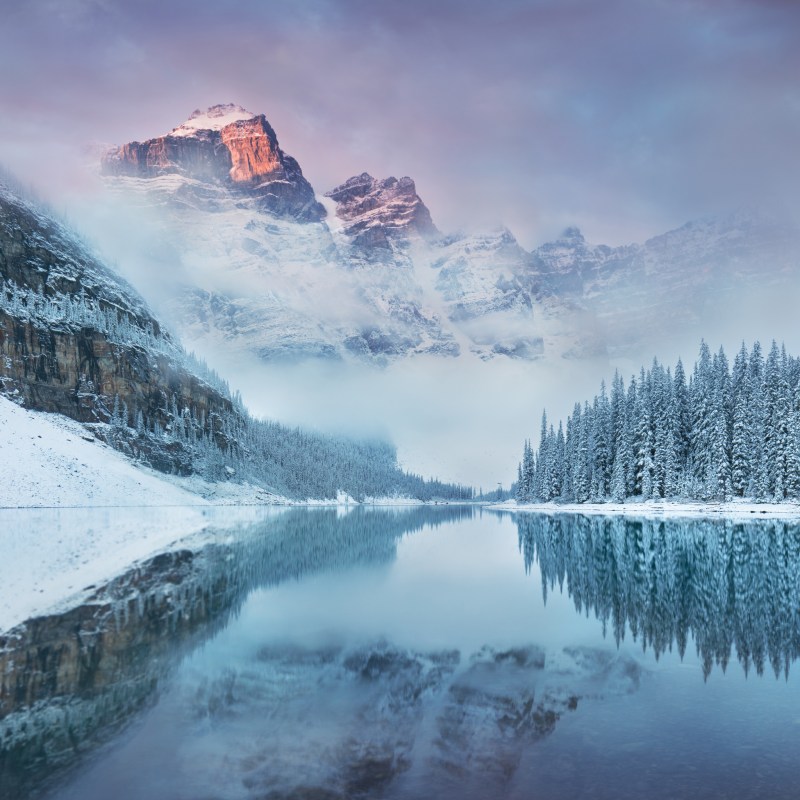
The magic scenery of Banff National Park in Alberta, Canada, is uplifting in winter, with bluebird skies, brilliantly white mountain-top glaciers, and crystal-clear ice. Photographers of all ability levels, and with equipment ranging from a cell phone to whatever high-end gear you can imagine, love the park’s combinations of light, snow, and ice.
Videos by TravelAwaits
From sweeping, large-format vistas to tiny hoarfrost details, Banff National Park is full of winter photography gems. Here are a few favorite locations and some photo tips to help you and your camera explore one of Canada’s biggest national parks in winter.

1. Visit Abraham Lake For Those Frozen Bubbles
The world loves the frozen methane bubbles of Alberta’s mountain lakes. Photographer Mark Unrau has taken some wonderful pictures of this remarkable sight. His company, Rocky Mountain Photo Adventures, offers photography workshops where you can shoot them for yourself.
The most famous place for lake bubbles is Abraham Lake, which is about 2 hours by road from the Banff townsite. It’s Unrau’s most popular tour.
Sometimes, the lakes closer to Banff also have ice bubbles, caused when the summer’s plants decay underwater and release methane just as the lake is freezing. With the right conditions, you might find bubbles in Lake Minnewanka or even at the warmer Vermilion Lakes.
For creative photography, this unusual subject hands it to you on a silver platter.
Pro Tips: In at least one of your photos, try to include something that will show the scale of the bubbles. It’s amazing how big they can get, and also how deep they go. Also, any kind of traveling on ice, whether it’s walking, skating, skiing, or something else, always carries some risk. Be sure to follow these safety tips from Parks Canada.

2. Capture Winter’s Short Days At Moraine Lake
The shortest day of the year in Banff is less than eight hours long. You don’t have to get up super early to be in place before sunrise.
In winter, the sun is much lower in the sky than in summer. This, too, is a gift to photographers. You can shoot all day long without getting the harsh, washed-out look that midday summer photos sometimes have.
You can capture both the coveted blue hour and golden hour (the twilight times bracketing sunrise and sunset) in the same day. Here’s a great photo study of twilight at Moraine Lake in Banff.
Pro Tip: Dress for winter. Overdress! Unlike cross-country skiing or skating on Lake Louise, photography involves a lot of being still. Keep your extremities warm, as well as your core. Wear warm, waterproof boots, a long coat or parka, mittens, a scarf, and a warm toque (hat). We’ve reviewed the best heated gloves, as well, if you want some extra warmth while you’re getting the perfect shot.

3. Mt. Rundle And Finding The Light In A Complex Landscape
Mountains make for unpredictable light and shadows.
“I like to go out early in the morning because in the Bow Valley, where Banff is, the sunrise has great light,” Unrau says.
Mt. Rundle and Cascade Mountain are close to the Banff townsite. It’s easy to capture them from different angles in one day if you have a car. Some good viewpoints are up on Tunnel Mountain, the top of the Banff Gondola, the Fairmont Banff Springs hotel and golf course, the main street through Banff, and the Vermilion Lakes.
With luck, you may spot ice climbers on Cascade.
Pro Tip: Bring your tripod. Use the self-timer or a remote so your camera will be as still as possible when the shutter opens. It’s surprising how much this can sharpen a picture.

4. Vermilion Lakes: Use Water For An Interesting Foreground
Unrau recommends finding an interesting foreground to make a good shot better. “I look for open water, where you can capture the reflection of the mountains,” he says.
The naturally warm water we love to bathe in at Banff’s Upper Hot Springs also keeps the Vermilion Lakes from freezing for much of the year, making this a great place for winter photography.
At times, you can see water vapor rising from the warm lake in winter. There’s a lot you can do with this, artistically.
Pro Tip: Keep your camera lens clean. You may walk through falling snow or find moisture condensing on the lens, just as it does on your glasses. Bring the appropriate cleaning cloths with you.
5. Phone Photos From The Ski Hill
If you’re in Banff for the skiing without your DSLR, you can still do some phone photography. Keep your phone in an inside pocket for warmth, or your battery may die. The same goes for camera batteries.
From the top of the Lake Louise Ski Resort, there’s a panoramic view of the lake and the romantic Fairmont Chateau Lake Louise hotel.
Pro Tip: For shooting in panorama mode on your phone, plant yourself in the position you want to finish up in. Rotate your body smoothly through the shot without moving your feet.

6. Ice Castle Magic At Lake Louise
Speaking of Lake Louise, every winter they make a skating rink and ice carvings right in front of the Chateau. The highlight is an exquisite ice castle.
This is a popular place for action shots of people skating, playing hockey, cross-country skiing, and taking horse-drawn sleigh rides, and also for romantic shots of the quiet lake when no one’s there.
Pro Tip: Stay at the Chateau or another Lake Louise hotel and get to the lake well before sunrise. The “no one’s there” part is challenging at one of Canada’s most notable photo hotspots.
7. Delicate Frost Flowers And Mountain Panoramas At Bow Lake
Snow and ice have many different forms, depending on things like air temperature, humidity, and wind. Sometimes during a cold, calm night, hoarfrost will grow on the trees like crystal moss. The best time to look for it is in the morning before it melts.
Frost flowers are equally delicate ice structures, making crystal clusters on the surface of a newly-frozen lake through the process of sublimation. Unrau says Bow Lake is a good place to find these.
From the tiny to the massive, Bow Lake is another place where you can get sweeping panoramic views of a lake and its surrounding mountains.
Pro Tip: Try close-ups of frost for creative, semi-abstract images.

8. Johnston Canyon, A Summer Favorite Seen In A New Way
Kim Logan of Banff and Lake Louise Tourism points out that Johnston Canyon, a very popular summer hike, is also a dramatic setting for winter photography. The canyon walls become covered in blue-white ice, completely changing the look of the place.
Pro Tip: Safety first. To hike in icy places like this, use the proper gear, especially sturdy ice cleats for your boots. Check the Parks Canada trail report for this favorite year-round trail.
9. Capture The Winter In Lake Minnewanka
Snow and ice accumulate in interesting layers, just like sedimentary rocks do. Keep your eyes open at the edges of lakes and streams. You may see bands of white and blue that your camera can capture.
Lake Minnewanka is a good place to explore. The wind sweeps down this long, narrow lake, sometimes leaving it clear enough to reflect the mountains and sky.
Pro Tip: Did you know you can change the exposure on your phone camera? On most smartphones, aim the camera and then hold your finger on the screen. This usually focuses the camera on the place you’ve put your finger, and it also brings up an image of the sun with a slider. Move the slider to let in more light if you want to brighten the shot.

10. Alpenglow From Sulphur Mountain
Sometimes Mother Nature is more generous to photographers than seems possible.
Alpenglow is a soft, pink light that appears to be coming from inside the mountains themselves. How it’s created is a little complicated, but it’s best in the winter and happens just before sunset.
There is no one place that will give you alpenglow reliably. Your best bet is to choose a point with a vast view. The Alpenglow Festival has all the ingredients: food, drink, and a prime location at the Banff Gondola summit. There’s even stargazing up here.
Pro Tip: Alpenglow and other light effects can very quickly change. Another valuable pointer from Unrau: Know your equipment. Learn to set up fast. When you can give your shot the full attention it deserves, you’ll be rewarded with better pictures.
Further Reading:
